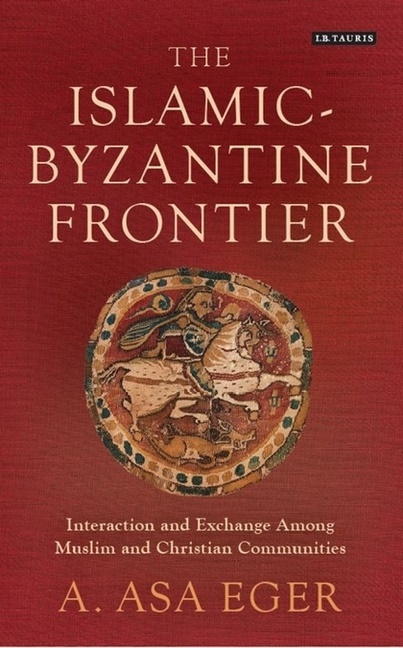Share
Fr. 44.50
a Asa Eger, A. Asa Eger, A Asa Eger, A. Asa Eger
The Islamic-Byzantine Frontier - Interaction and Exchange Among Muslim and Christian Communities
English · Paperback / Softback
Shipping usually within 3 to 5 weeks
Description
Informationen zum Autor A. Asa Eger is Assistant Professor in the Department of History at the University of North Carolina, Greensboro. He holds a PhD in Islamic Archaeology from the University of Chicago. Klappentext The retreat of the Byzantine army from Syria in around 650 CE, in advance of the approaching Arab armies, is one that has resounded emphatically in the works of both Islamic and Christian writers, and created an enduring motif: that of the Islamic-Byzantine frontier. For centuries, Byzantine and Islamic scholars have evocatively sketched a contested border: the annual raids between the two, the line of fortified fortresses defending Islamic lands, the no-man's land in between and the birth of jihad. In their early representations of a Muslim-Christian encounter, accounts of the Islamic-Byzantine frontier are charged with significance for a future 'clash of civilizations' that often envisions a polarised world. A. Asa Eger examines the two aspects of this frontier: its physical and ideological ones. By highlighting the archaeological study of the real and material frontier, as well as acknowledging its ideological military and religious implications, he offers a more complex vision of this dividing line than has been traditionally disseminated. With analysis grounded in archaeological evidence as well the relevant historical texts, Eger brings together a nuanced exploration of this vital element of medieval history. Zusammenfassung The retreat of the Byzantine army from Syria in around 650 CE, in advance of the approaching Arab armies, is one that has resounded emphatically in the works of both Islamic and Christian writers, and created an enduring motif: that of the Islamic-Byzantine frontier. For centuries, Byzantine and Islamic scholars have evocatively sketched a contested border: the annual raids between the two, the line of fortified fortresses defending Islamic lands, the no-man's land in between and the birth of jihad. In their early representations of a Muslim-Christian encounter, accounts of the Islamic-Byzantine frontier are charged with significance for a future 'clash of civilizations' that often envisions a polarised world. A. Asa Eger examines the two aspects of this frontier: its physical and ideological ones. By highlighting the archaeological study of the real and material frontier, as well as acknowledging its ideological military and religious implications, he offers a more complex vision of this dividing line than has been traditionally disseminated. With analysis grounded in archaeological evidence as well the relevant historical texts, Eger brings together a nuanced exploration of this vital element of medieval history. Inhaltsverzeichnis Introduction: Islamic Frontiers Real and ImaginedPart I: The Syro-Anatolian ThughurChapter 1: The Central Thughur: The Two AmuqsChapter 3: The Central Thughur: The Steppe and the RiverChapter 3: The Eastern ThughurChapter 4: The Jazira (Balikh and Khabur River Valleys)Chapter 5: The Western Thughur: Crossroads of CiliciaPart II: Hydraulic Villages and Fortified Castles: A Narrative of SettlementChapter 6: Upland Settlements in the Late Roman Period (Fourth to Seventh Centuries)Chapter 7: Hydraulic Villages in the Early Islamic Period (Seventh to Tenth Centuries)Chapter 8: Pastoralism on the Byzantine Frontier (Seventh to Tenth Centuries)Chapter 9: Fortified Castles of the Middle Islamic/Byzantine Period (Tenth to Fourteenth Centuries)Chapter 10: Frontier or Frontiers: Social and Environmental InteractionsConclusion: Dismantling and Rebuilding the Frontier...
List of contents
Introduction: Islamic Frontiers Real and Imagined
Part I: The Syro-Anatolian Thughur
Chapter 1: The Central Thughur: The Two Amuqs
Chapter 3: The Central Thughur: The Steppe and the River
Chapter 3: The Eastern Thughur
Chapter 4: The Jazira (Balikh and Khabur River Valleys)
Chapter 5: The Western Thughur: Crossroads of Cilicia
Part II: Hydraulic Villages and Fortified Castles: A Narrative of Settlement
Chapter 6: Upland Settlements in the Late Roman Period (Fourth to Seventh Centuries)
Chapter 7: Hydraulic Villages in the Early Islamic Period (Seventh to Tenth Centuries)
Chapter 8: Pastoralism on the Byzantine Frontier (Seventh to Tenth Centuries)
Chapter 9: Fortified Castles of the Middle Islamic/Byzantine Period (Tenth to Fourteenth Centuries)
Chapter 10: Frontier or Frontiers: Social and Environmental Interactions
Conclusion: Dismantling and Rebuilding the Frontier
Product details
| Authors | a Asa Eger, A. Asa Eger, A Asa Eger, A. Asa Eger |
| Publisher | Tauris, I.B. |
| Languages | English |
| Product format | Paperback / Softback |
| Released | 01.12.2016 |
| EAN | 9781784539191 |
| ISBN | 978-1-78453-919-1 |
| No. of pages | 432 |
| Series |
I.B.TAURIS Library of Middle East History I.B.TAURIS |
| Subjects |
Humanities, art, music
> History
> Middle Ages
Social sciences, law, business |
Customer reviews
No reviews have been written for this item yet. Write the first review and be helpful to other users when they decide on a purchase.
Write a review
Thumbs up or thumbs down? Write your own review.

